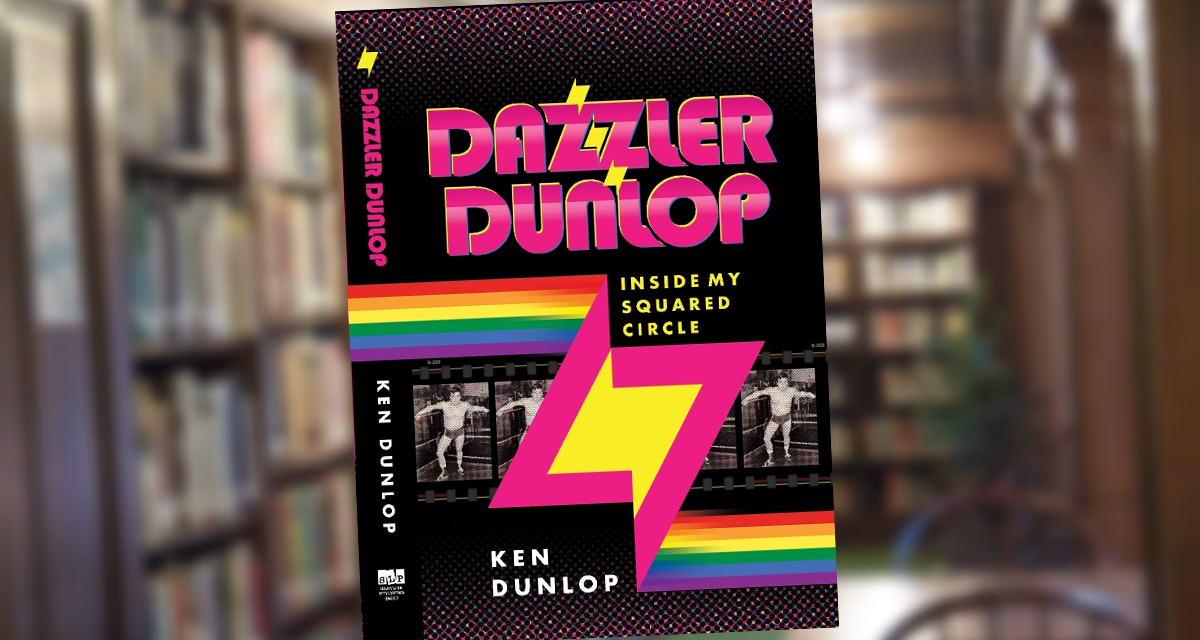When I say: “Aussie Aussie Aussie!”
You say: “Oi Oi Oi!”
Over the last several years, pro wrestling fans have had the opportunity to witness the grappling talent from the land down under via Australian wrestlers like Buddy Murphy, Tenille Dashwood, Toni Storm, Rhea Ripley, Billie Kay and Peyton Royce just to name a few.
And for those fans who are eager to learn more about the Aussie pro wrestling scene, I have some good news for you: you don’t have to shell out hundreds of dollars for a plane ticket! You can simply pick up Aussie born and bred Ken “Dazzler” Dunlop’s autobiography, Dazzler Dunlop: Inside my Squared Circle. The book is out now from Shawline Publishing Group. (Sadly, no kangaroos, Paul Hogans, or shrimps on the barbie are included in Dunlop’s brisk, yet incredibly candid tome! I’ll see myself out!)
“In 23 years, I have basically done it all,” shared the 61-year-old Dunlop, who during his career has taken on the roles of wrestler (singles and tag team), referee, trainer, booker and promoter. “I’ve wrestled in the heat, the cold, and the wet. I’ve wrestled in the morning, afternoon, night, and after midnight. I’ve wrestled in hair matches, lumberjack matches, chain matches, tables-and-chair matches, and cage matches. I’ve wrestled big guys, small guys, women and dwarves. I’ve wrestled with and against my brother (Allan Dunlop aka “Red Hot” Ricky Diamond), legends of the sport, pupils, and people who have no right being in the ring. I’ve wrestled in front of crowds of prisoners, soldiers, mental home patients, cruise ship passengers, and crazy fans who bayed for my blood. As you can see, I was just happy to wrestle anywhere, anytime, and in any conditions, and to me that is what being a true professional wrestler was all about.”
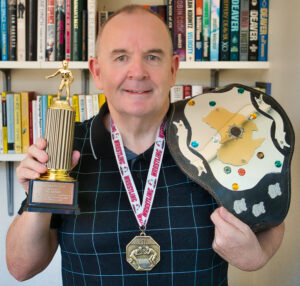
Ken “Dazzler” Dunlop shows off his career accolades: an Over the Top trophy, a medallion from The New Age Wrestling Hall of Fame and the Australian tag team title belt. All photos courtesy of Dunlop.
SlamWrestling.net recently interviewed Dunlop, who currently resides in Sydney, Australia, via email about sharing his life story with the masses:
SlamWrestling.net: Why did you want to share your story in a book?
Ken Dunlop: When I got together with some of the other wrestlers I was involved with or some fans who became friends, I would regale them with stories from my wrestling career and they said I should write a book. I never had time while I was working but after I retired from work at age 56 due to ill health, I had plenty of time so I sat down most mornings to work on it. It took me two years on and off but I finally got there!
Slam: What was the most difficult section or chapter to write and why?
Dunlop: (The chapter) “Lowlights and a ‘Hart-break’” as I had to bring up some very painful memories. I wasn’t going to have that chapter originally but I thought as I only get one chance to tell my story I wanted to be as honest as possible. EDITOR’S NOTE: In this chapter Dunlop shares his struggles with mental health, the death of close friends and his mother suffering a massive stroke. In addition, Dunlop was invited by Stu Hart to come work for Stampede Wrestling in Calgary, Alberta, Canada. Just weeks before he was set to leave, Hart told Dunlop he had sold his promotion to Vince McMahon, Chairman and CEO of World Wrestling Entertainment (WWE). Dunlop’s dreams of wrestling in North America were officially shattered.
Slam: When you first talk about your pro wrestling training, it seems to go pretty smoothly without the expected initiation horror stories many pro wrestlers have, but then later in the book you mention that a trainer was indeed abusive, can you talk about this experience a little more?
Dunlop: At the beginning I had five trainers and one of them was a very tough man. He was a good trainer, but if I made a mistake he would yell and scream at me, smack me hard around the back of the head, or sometimes kick me really hard in the arse. That was probably the way back in the 1970s but he was harder than the others to please.
Slam: How did this experience impact your techniques when you starting training pro wrestlers?
Dunlop: It didn’t affect my training methods that much, but I was a hard taskmaster myself. Whether that had to do with the way I was trained, I’m not sure, but while I would yell at my pupils, I was never physically abusive.
Slam: How would you describe yourself as a wrestler? What were your strengths and weaknesses?
Dunlop: I was a technical wrestler, very stiff, but I could brawl equally well. I had great stamina, having wrestled in many matches that went 45 minutes or longer (including a few one-hour matches). My weakness was not being blessed with a muscular body that you typically see in wrestlers today, and even though I worked hard in the gym, I hated doing weights. I don’t think it held me back or harmed my career but it did not help with my prospects overseas.
Slam: You are very candid in the book about your sexual experiences, being gay, drug use in wrestling, the toll wrestling has taken on your body and of course being hit on by the late Queen front man, Freddie Mercury… why did you decide to be so open to readers?
Dunlop: I have read a few wrestling autobiographies over the years and I believe that a lot of them aren’t totally honest, and a few of my wrestling friends who have read many more than me have said the same. Again, because I felt that I am only telling my story once, I wanted to include as much as possible and be as honest as I could.
Slam: As a gay man, did you truly feel accepted by your wrestling peers? Were there ever any incidents where you were treated differently or badly by anyone involved in pro wrestling because of being gay?
Dunlop: In a way I was definitely very lucky. No one ever said anything about my being gay to my face (that I know of), but l knew a few that talked behind my back. A few of the older wrestlers didn’t like me right from the start but I don’t think that had anything to do with my sexuality. I was open about it but I never flaunted it nor did I talk about it much with the guys.
Slam: In the book, you mention being involved in one intergender match during your career. I’m curious what your thoughts are on intergender matches?
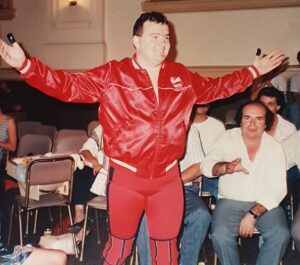
In his autobiography, Dunlop is incredibly positive and forthright about his 23 years in the squared circle.
Dunlop: I am not a huge fan of intergender matches. I only did the one intergender match out of necessity, as I needed to fill in time. Back then in the clubs in Sydney, we were required to do a two-hour show with a 15-minute interval. On that day, two wrestlers didn’t turn up, so as the promoter and booker, I had to change the show on the spot and an intergender match was the only thing I came up with. It worked out really well but I did get into strife with the Department of Sport and Recreation as intergender matches were still illegal at the time (they weren’t legalized here until the year 2000).
Slam: Since you brought up the Department of Sport and Recreation, in the book you explain that the Sydney wrestling scene for a time fell under the jurisdiction of the New South Wales Department of Sports and Recreation. Do you think all pro wrestling promotions, despite their location, should be regulated by a group similar to the one previously with jurisdiction in Sydney? Why or why not?
Dunlop: Yes, definitely. I thought it was great that Sydney was regulated by the Department of Sport and Recreation. All the wrestlers had to have a full medical every three months (which I think is vital), there were strict guidelines to follow (although I must admit we did break some on occasions), and we had to have full comprehensive insurance to protect the wrestlers. In Melbourne there were no regulations whatsoever and that made it so much more chaotic. They could do shows anywhere, used a lot of older guys who were way past their prime, and did more dangerous matches, but that freedom came at a cost of professionalism. I worked in both Sydney and Melbourne so I had firsthand experience seeing the contrast between the two scenes, and Sydney being more regulated was definitely superior. Sydney had more than double the amount of shows too. In Sydney, after the year 2000, the Department dropped wrestling from their jurisdiction and I think the business has suffered since.
Slam: What life lessons did you take away from your involvement in pro wrestling?
Dunlop: I made many friendships from the time I had in wrestling, but the main lesson I learnt was to trust and respect my fellow workers. It taught me how to run a business successfully while working a full-time job and to work hard. Finally, it gave me great satisfaction mentoring many young men from all walks of life.
Slam: Many of our readers have not had the opportunity to travel to Australia to experience the pro wrestling scene there, how would you describe the differences and similarities between North American and Australian pro wrestling?
Dunlop: Although I’ve never wrestled in America, my thinking is that they are quite similar. In Australia, we really had to work our butts off in the ring, wrestling non-stop. Some of the American wrestlers who toured here over the years told me they were surprised with that. They remarked that they had to work harder in Australia as the fans here just want the action without the stalling or too much storyline bulls**t.
Slam: “Ribbing” (wrestlers playing practical jokes) has been very popular in North American wrestling. What is the view on ribbing in Australian wrestling? Did you ever pull an epic rib?
Dunlop: Ribbing doesn’t play a big part here in Australia; occasionally we would do something silly or funny but it was mainly for our own amusement. Once I did a six-man tag where we set one guy up for a fart prank; all the other guys knew as well as the referee and announcer so the stooge was the only one oblivious. It was very funny. EDITOR’S NOTE: During the aforementioned match, wrestler Corporal Hardy was the victim of his opponents loudly accusing him of farting during the bout. Even the referee and his tag team partners joined in by fanning their faces and feigning disgust.
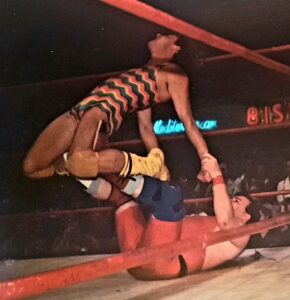
Dunlop has Jumping Josh in a surfboard.
Slam: You mention in the book that you wrote a column for the magazine, Wrestling Down Under, can you tell me about what you would write about in your columns and how often you would write them?
Dunlop: It was a monthly magazine and I mainly wrote about the young guys that I was training and mentoring to build them up. I would also mention some of my promotion’s storylines.
Slam: Why did you decide to include a chapter on Chronic traumatic encephalopathy (CTE)?
Dunlop: I did it because CTE is a very important and serious health issue and it’s not often talked about. Most wrestlers will suffer concussion at some stage of their career. During mine, I had at least 14 and I know they have affected my short-term memory, which makes me worry about my future, and many older wrestlers end up with dementia, which is really sad. By having a chapter in my book, I hope to raise more awareness and hopefully one day soon, there can be a cure found, or at the very least, better treatment available. EDITOR’S NOTE: Dunlop has signed up to be a brain donor and currently undergoes yearly tests for further research into CTE.
Slam: What was your approach to concussions when you were a promoter and/or trainer?
Dunlop: I tried my best to teach my pupils how to look after themselves properly, and only once did one of them get concussed in a match. I drove him home and stayed with him for a few hours and explained to his mother what was happening and by the next afternoon he was fine. During my time there was no official protocol regarding concussions. It was just seen as being part of the job, but when I promoted, I made sure everyone who got a concussion went to their doctor to get a medical clearance before I would allow them back to participate in training or matches.
Slam: Who was your favorite wrestler growing up and why?
Dunlop: I had two local Australian wrestlers who I greatly admired: Ken Medlin and Johnny Gray. Both were fantastic workers with great ring psychology. My favorite overseas guy during the ’70s was King Curtis as he was the greatest ever on interviews, could move pretty fast for a big guy, and take big bumps and sell like crazy. In the ’80s I couldn’t go past Ric Flair and Ricky Steamboat; their classic three-match series is legendary and pro wrestling at its finest.
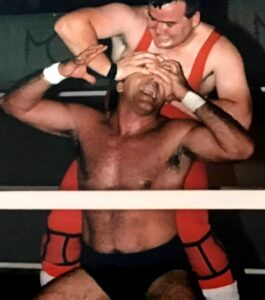
Dunlop mauls George Zorbas at the Marrickville Town Hall in 1989.
Slam: Who is your favorite wrestler now and why?
Dunlop: I don’t watch a lot of current wrestling, but what I have seen I’ve been impressed with. We have two great young Australian wrestlers in Robbie Eagles and Banjo Powers who are very exciting, and I do love watching Sammy Guevara, who has a very bright future.
Slam: As an aside, in your chapter, “My Perfect Wrestler,” where you analyze the essential characteristics for being a pro wrestler, you reveal that you are not a fan of Hulk Hogan. I was just curious as to why? Did you ever have the opportunity to meet him in person?
Dunlop: No, I have never met him. To me he is the first one not to sell his opponents’ big moves. He didn’t sell well and I thought he was very lazy in the ring. He really needed a strong opponent to make him look good and he could not control the match. He did have a great gimmick and ring personality however, and that is what saved him.
Slam: You took on so many roles in pro wrestling, which role was your favorite and why?
Dunlop: I loved promoting and training new guys. To see them with the same love, respect, and passion for the business as I had really warmed my heart.
Slam: What advice do you have for men and women wanting to break into the wrestling business?
Dunlop: Try to find an old-fashioned training school that will teach the basics first. Learn all the breakfalls, holds, and counter holds until they become second nature. I believe that high spots should never be taught until the basics are mastered first. And try to be true to yourself.
Slam: What involvement do you have in pro wrestling today?
Dunlop: I have no involvement anymore. Today I am just a fan. I have reached out to a few workers via social media and offered advice.
Slam: What are your thoughts on some of the men and women from Australia currently active in the pro wrestling scene?
Dunlop: I am extremely proud to see so many Aussies on the world scene making their mark. It is much easier these days than in my time.
Slam: What do you miss the most about being an active pro wrestler?
Dunlop: I miss the friendships and being around the guys every week. Although I am still in touch with many of them, it’s not the same as the fantastic fun we had in the dressing rooms and during training and shows.
Slam: What do you want readers to take away from your book?
Dunlop: Wow, what a question. It has never been asked and I really had to think hard about it. I only wrote this as my story but I hope it inspires people to follow their dreams and to be true to themselves.
Slam: Ken, was there anything you wanted to add or anything that I missed?
Dunlop: I think we have covered everything. One thing is that no one should ever go into this crazy, fantastic business for the money, because not many can make a good living from it. To succeed you first must respect the business and have love and passion for it. All these bookers for the big promotions should all be from within the business.
EDITOR’S NOTE: This interview has been edited for length and clarity.
RELATED LINKS
- Buy Dazzler Dunlop: Inside my Squared Circle from Amazon.ca or Amazon.com
- Ken Dunlop: Facebook and Instagram
- Shawline Publishing Group: Website and Facebook
- SlamWrestling Master Book List
